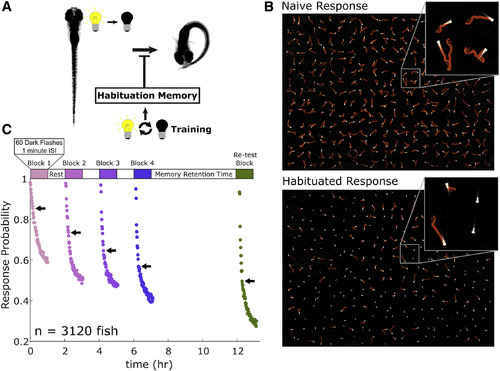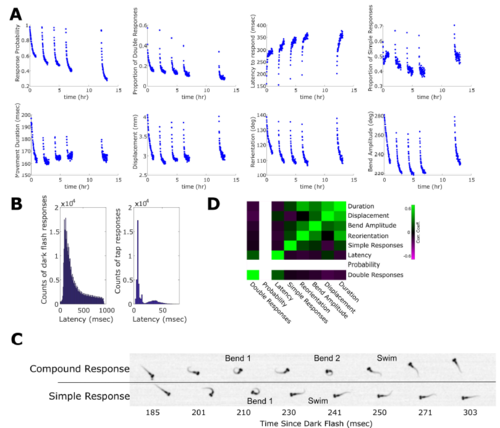- Title
-
Distributed Plasticity Drives Visual Habituation Learning in Larval Zebrafish
- Authors
- Randlett, O., Haesemeyer, M., Forkin, G., Shoenhard, H., Schier, A.F., Engert, F., Granato, M.
- Source
- Full text @ Curr. Biol.
|
Habituation of the Dark-Flash Response (A) When stimulated with a dark flash, larval zebrafish execute a high-amplitude turn, which habituates with training [14]. (B) Time projection images from a 0.9-s recording of the same 300 larvae for the first flash (naive response) and the 240th flash (habituated response). Motion is visible as orange streaks in the image, tracing the path traveled by the larvae. Larvae that do not move are visible as stationary white larvae (insets). Larvae were recorded in 300-well plates, and images were background subtracted to remove the behavior plates. (C) The response probability across the population of larvae decreased both within the 60-flash training blocks and successively across the 4 blocks of training. Each dot represents the proportion of larvae that respond to each stimulus, which are delivered at 1-min interstimulus intervals (ISIs). Memory was evident at the re-test block 5 h after training, where larvae have not recovered to untrained levels (those in block 1). Arrows, 10th stimulus in each block. |
|
Habituation of dark flash response components. Related to Figures 2 and 3. A) Habituation is evident in 8 different components of the response, each dot represents the mean response to each stimulus (n=3120 larvae). B) Histograms of the distribution of latencies observed in response to dark flashes. n = 392161 responses in 3120 larvae (left). Histograms of the bimodal distribution of latencies observed in response to taps. n = 44515 responses in 3120 larvae (right). C) A “Compound Response” is defined as a movement where a large angle bend (Bend 1) is followed by a period of partial relaxation of the bend, before performing a second large angle bend (Bend 2). Finally, the larva fully relaxes and swims forward. In contrast, a “Simple Response” is characterized by a single large angle bend (Bend 1), which fully relaxes and the larva swims forward. C) Correlation matrix quantifying how correlated individual components of the dark flash response are in naïve larvae (Spearman’s Rho). The matrix is sorted as to match Figure 3D. Note that the “Probability” component can not be compared with the other components, since the remaining components can only be analyzed in conditions when a larva responds to the flash |


